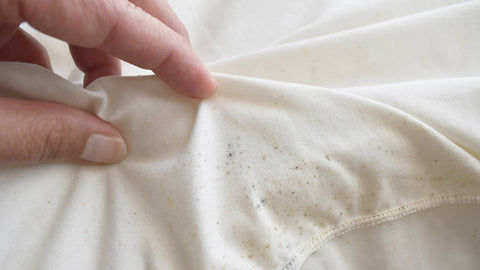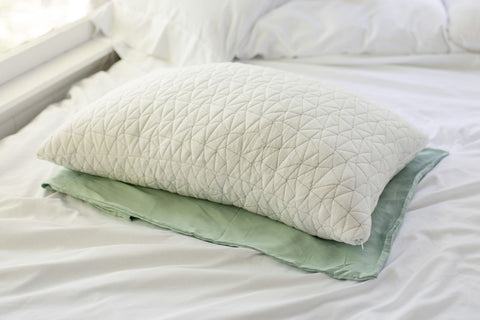Washing your pillows regularly is essential for maintaining a clean and healthy sleep environment. To wash most pillows, submerge them in lukewarm water with mild detergent and gently squeeze to remove dirt and stains. This simple process helps eliminate dust mites, allergens, and bacteria that accumulate over time.
Different pillow types may require specific cleaning methods. For machine-washable pillows, use a gentle cycle with warm water and mild detergent. Hand-washing is often best for memory foam or down pillows to preserve their shape and quality. Vacuum the surface of pillows that can't be washed, like latex or buckwheat, and spot clean any stains.
Proper pillow maintenance not only extends their lifespan but also supports better sleep hygiene. Clean pillows can reduce allergy symptoms and improve overall sleep quality. Remember to wash your pillows every 3-6 months and replace them when they no longer provide adequate support.
Preparing Your Pillows for Washing
Proper preparation is crucial for effectively washing your pillows. Taking the time to assess your pillow type, check care labels, and pre-treat stains will ensure the best cleaning results.
Assessing Pillow Types
Different pillow materials require specific cleaning methods. Memory foam pillows should not be submerged in water. Instead, vacuum them regularly and spot clean with a damp cloth and mild detergent. Down and feather pillows can usually be machine washed, but require gentle handling. Latex pillows are typically not washable and should be spot cleaned only. Polyester pillows are often the easiest to wash and can usually withstand machine washing.
Check your pillow's material before proceeding with any cleaning method. If you're unsure, err on the side of caution and opt for gentler cleaning techniques.
Reading Care Label Instructions
Always consult the care label on your pillow before washing. These labels provide valuable information about recommended cleaning methods, water temperature, and drying instructions. Some pillows may require dry cleaning only.
Pay attention to specific warnings or restrictions. For example, some pillows may need to be washed in pairs to maintain the washing machine's balance. Others might have temperature limitations for both washing and drying.
Ignoring care label instructions can lead to damaged pillows or voided warranties. If the label is missing or illegible, research the manufacturer's recommendations online or contact them directly.
Pre-Treatment of Stains
Before washing, examine your pillows for any stains. Treat these areas to ensure thorough cleaning:
- Remove pillowcases and protectors
- Identify stain types (sweat, oil, food, etc.)
- Apply appropriate stain remover
- Gently work the solution into the fabric
- Allow the treatment to sit for 15-30 minutes
For stubborn stains, create a paste using baking soda and water. Apply it to the stained area and let it dry before brushing off. This method can help absorb oils and odors.
Remember to test any stain treatment on a small, inconspicuous area first to ensure it doesn't damage or discolor the pillow fabric.
Selecting the Correct Washing Method
Proper pillow cleaning depends on the material and construction. Choose the right method to ensure your pillows stay fresh and undamaged.
Machine Washing Pillows
Check your pillow's care label to see if it's machine-washable. Most synthetic and down pillows can be washed in a machine. Use a gentle cycle with cold water to prevent filling from clumping. Add a small amount of mild detergent to the washer.
Wash two pillows at a time to balance the load. This helps maintain the washing machine's stability during the spin cycle. Place pillows vertically in a front-loading machine or agitator-free top-loader for best results.
After washing, run an extra rinse cycle to remove all soap residue. This step is crucial for preventing skin irritation and extending your pillow's life.
Hand Washing Delicate Pillows
For delicate pillows or those not suitable for machine washing, hand washing is the safest option. Fill your bathtub with lukewarm water and add a small amount of mild detergent. Submerge the pillow and gently squeeze to allow soapy water to penetrate the filling.
Avoid twisting or wringing the pillow, as this can damage its structure. Instead, press and release the pillow repeatedly to clean it thoroughly. Drain the soapy water and refill the tub with clean water to rinse.
Repeat the rinsing process until the water runs clear. Gently press out excess water without twisting. Pat the pillow with a clean towel to absorb moisture before drying.
Drying and Fluffing Pillows Post-Wash
Proper drying and fluffing are crucial steps to restore your pillows' shape and comfort after washing. These techniques ensure your pillows are thoroughly dry and maintain their loft.
Using a Dryer With Care
Set your dryer to low or medium heat to avoid damaging the pillow fibers. Add two or three dryer balls or clean tennis balls to help fluff the pillows as they dry. This prevents clumping and ensures even drying.
Check your pillows every 30 minutes and remove them once they feel dry to the touch. Overdrying can damage the filling.
For down or feather pillows, use the air-dry or no-heat setting to prevent scorching. Extend the drying time as needed.
Synthetic pillows typically dry faster than down or feather ones. Remove them promptly to avoid excessive heat exposure.
Air-Drying Techniques
Lay your pillows flat on a clean, dry surface in a well-ventilated area. Ensure they're not in direct sunlight, which can cause discoloration or fabric damage.
Flip the pillows every few hours to promote even drying. Gently squeeze them to check for damp spots.
If weather permits, hang your pillows outside on a clothesline. The fresh air helps eliminate odors and the breeze aids in fluffing.
For faster drying, use a fan to circulate air around the pillows. This method is especially useful for foam pillows that can't go in the dryer.
Once dry, give your pillows a good shake and hand-fluff to restore their shape before use.
Maintaining and Replacing Pillows Over Time
Proper pillow care extends their lifespan and ensures a hygienic sleep environment. Regular maintenance and timely replacement are key to optimal comfort and health.
Regular Pillow Maintenance
Vacuum your pillows monthly to remove dust and allergens. Use the upholstery attachment and go over both sides thoroughly. Spot clean stains immediately with a mild detergent solution.
Use pillow protectors under your pillowcases. These act as barriers against sweat, oils, and dead skin cells. Wash protectors every 2-4 weeks with your regular laundry.
Fluff your pillows daily to maintain their shape and loft. This redistributes the filling and prevents clumping. For down or feather pillows, air them outside on a sunny day every few months.
Knowing When to Replace
Replace your pillows every 1-2 years. Signs it's time for new pillows include:
- Lumps or flat spots that don't fluff out
- Yellowing or visible stains
- Persistent odors even after washing
- Increased allergy symptoms
Fold your pillow in half. If it doesn't spring back to shape, it's lost its support. Memory foam pillows may last up to 3 years with proper care.
Consider replacing pillows more frequently if you have pets that sleep on your bed or if you have allergies. Bacteria and dust mites accumulate over time, making older pillows potential allergen hotspots.



